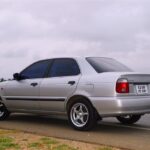Suzuki S-Cross 2022: Full Review and Hybrid Technology Explained
Introduction
The Suzuki S-Cross 2022 offers a fresh look, updated technology, and improved efficiency thanks to its 48V mild-hybrid system. With more equipment and enhanced design, this compact SUV aims to stand out in a competitive market. The addition of Suzuki’s 1.4-liter Boosterjet engine paired with mild-hybrid tech brings a claimed 20% improvement in running costs. Along with this, the S-Cross offers ample space, a host of features, and the option of a lockable all-wheel-drive system for those seeking more versatility.
Engine and Performance
At the heart of the Suzuki S-Cross 2022 is its 1.4-liter Boosterjet hybrid engine, delivering 129 horsepower and benefiting from mild-hybrid technology. For those unfamiliar with mild-hybrid systems, here’s a brief explanation: when braking or cruising, energy that would typically be lost is captured via a kinetic energy recovery system. This energy is then stored in a small lithium-ion battery placed under the passenger seat, which powers the integrated starter generator (ISG) and the vehicle’s stop-start system.
This 48V setup allows the car to idle and even coast on electric power alone, though only at speeds below 10 mph. Additionally, the mild-hybrid system helps reduce turbo lag by providing a torque boost during acceleration, which is particularly useful given that the hybrid system adds 65 kilograms to the vehicle’s overall weight. The car reaches 62 mph in 10.2 seconds and has a top speed of 118 mph. An automatic transmission is available as an option, along with Suzuki’s AllGrip four-wheel-drive system on the top Ultra variant.
Exterior Design: A Sharper Look
The updated design of the S-Cross 2022 gives it a more muscular and modern appearance, much needed for its segment. The front features a raised bonnet line, a piano-black front grille, and three LED position headlamps that create a bold look. The larger, more angular wheel arches and smooth flowing lines contribute to the SUV’s newfound presence.
At the rear, larger combination lamps blend seamlessly with the rear center garnish, emphasizing the car’s width. The integrated rear spoiler and roof rails further enhance its rugged design. Although the overall dimensions of the S-Cross remain unchanged, its 4,300mm length places it firmly in the mid-sized crossover category, giving it a solid stance.
Interior and Technology
Inside, the Suzuki S-Cross remains practical and functional. While the interior design is relatively simple, it feels well-built, with sturdy materials used throughout. Some areas might feel a bit plasticky, but the overall feel is solid and durable, thanks to Suzuki’s production quality at its Hungarian factory.
The centerpiece of the interior is the infotainment system, which includes a touchscreen display offering satellite navigation, Apple CarPlay, Android Auto, a DAB radio, and Bluetooth connectivity. Though the graphics might feel slightly outdated, the system is packed with useful features and is easy to use. The high-spec Ultra variant also includes additional comfort features, such as leather seats, dual-zone climate control, and a panoramic sliding sunroof.
Passenger and Cargo Space
The Suzuki S-Cross impresses with its interior space, especially considering its compact dimensions. The rear seats provide plenty of legroom, although headroom might be slightly reduced for taller passengers in models with the dual sunroof. The rear bench doesn’t slide, but the backrest reclines slightly for added comfort. Even with these limitations, the cabin feels spacious and airy.
In terms of cargo capacity, the S-Cross offers 430 liters of boot space, which is about 20% larger than what you’d find in many smaller crossovers. The boot features a false floor for additional hidden storage, along with lidded compartments behind the wheel arches and handy hooks for bags. Unfortunately, when the rear seats are folded down, the overall capacity increases only to 875 liters, which is less than what some competitors offer. Still, the flat loading bay created by the false floor makes loading larger items easier.
Fuel Efficiency and Running Costs
Suzuki claims the 48V mild-hybrid technology delivers up to 20% better fuel economy and lower emissions, though real-world benefits may be slightly less. According to official WLTP figures, the front-wheel-drive version of the S-Cross achieves 53.2 mpg and emits 120 grams of CO2 per kilometer. The all-wheel-drive variant is slightly less efficient, with fuel consumption rated at 47.8 mpg and emissions at 133 grams of CO2 per kilometer. These figures are still competitive within the crossover segment.
Thanks to its lightweight construction, the S-Cross remains one of the lightest SUVs in its class, even with the added hybrid tech. Weighing just 1,220 kilograms in its all-wheel-drive configuration, the car maintains a favorable balance between efficiency and performance.
Insurance costs are also manageable, with the vehicle falling into group 25D for the base model and 26D for the top-spec Ultra trim. Like all Suzuki models, the S-Cross comes with a three-year or 60,000-mile warranty, along with a year of roadside assistance, ensuring peace of mind for owners.
Pricing and Features
Pricing for the Suzuki S-Cross has risen slightly compared to previous models, with the entry-level 1.4 Boosterjet Hybrid Motion variant starting at around £25,000. The top-spec Ultra AllGrip version with manual transmission is priced just under £30,000. For an additional £1,350, you can opt for a six-speed automatic transmission on both trims.
Standard equipment on the base Motion model includes seven airbags, 17-inch alloy wheels, LED headlights, Apple CarPlay and Android Auto, traffic sign recognition, adaptive cruise control, keyless entry, dual-zone air conditioning, heated front seats, and parking sensors. The higher Ultra trim adds features like leather upholstery, integrated navigation, a panoramic sunroof, and a 360-degree camera.
Conclusion
The Suzuki S-Cross 2022 builds on its predecessor’s strengths, offering an efficient hybrid system, spacious interior, and a more refined design. While the hybrid technology provides only marginal improvements in fuel economy, it does enhance the overall driving experience with added torque and smoother performance.
After exploring the S-Cross myself, I found a reviewer with a similar perspective on the model. Their insights helped me appreciate the S-Cross even more. If you’re interested, you can watch the full review here: Suzuki S-Cross 2022 | FULL REVIEW.






